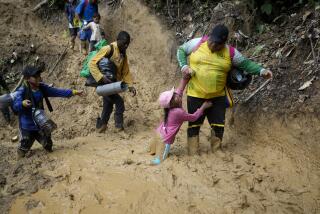Exploiters Won’t Get This Activist’s Mark : India’s Kailash Satyarthi has devised a label certifying that a carpet was made without child labor.
- Share via
NEW DELHI — It was 14 years ago that Kailash Satyarthi and his followers began staging daring raids on Indian workplaces to free children who were being treated little better than slaves.
To date, the tall, bearded activist from central India estimates, he has helped retrieve 25,000 children, including 7,000 from the carpet industry, and reunited them with their parents.
It’s not enough, he says.
Often, muses the chairman of the South Asian Coalition on Child Servitude (SACCS), he would go to a station to catch the train home after raiding a carpet manufacturing plant in Uttar Pradesh state, where children are forced to work no less than 12 and as many as 20 hours a day.
Feeling pleased with himself for having freed 10 children, Satyarthi would then watch, aghast, as a labor broker arrived in Varanasi or Mirzapur on an inbound train with 50 new youngsters to satisfy the industry’s endless hunger for labor.
“We are freeing children at the cost of our lives, but the number of child laborers keeps rising,” Satyarthi says. When he speaks of the risks involved, he is not speaking idly. Two of his comrades have been killed--one shot to death, the other beaten so badly he succumbed to his injuries. Employers, or their agents, were to blame, he says.
The solution to India’s child labor problems, the coalition’s founder has concluded, lies not in India but in the United States and other foreign countries that buy 98% of India’s carpets.
In Germany, he noticed during a 1990 visit, tomatoes are labeled to alert the consumer that they are environment-friendly and healthy. “I said, ‘If you are so concerned about your health and environment, why not show the same concern for children?’ ”
By the end of this year, Satyarthi expects the result of his lobbying, negotiating and coalition-building involving Indian and foreign grass-roots organizations and charities to be available to consumers in Europe and North America: a label, called the “rugmark,” certifying that a carpet was made without child labor.
*
All other carpets from India and neighboring Nepal and Pakistan should be boycotted, he says.
“If you put your legs on a beautiful Indian carpet, you are crushing the backbone of a child,” he insists.
More than 50 Indian carpet makers have agreed to the rugmark scheme, Satyarthi said in a recent interview at his group’s New Delhi headquarters.
The cooperating companies have provided a list of their weaving units so that inspectors from his group can verify that no children are employed on their premises. That’s necessary, he says with a wry smile, because the industry can’t be trusted to police itself.
“When the All India Carpet Manufacturers Assn. talked about putting on the label, I was 100% sure that not only would it be a fake label but that they would build a new factory to make it where children would be employed,” he says.
The rugmark, Satyarthi says, will be awarded by an independent body that includes representatives of carpet manufacturers and exporters; non-governmental social service organizations; U.N. agencies such as UNICEF and the International Labor Organization, and the Indo-German Export Promotion Project.
“Now it is going to function,” Satyarthi said with confidence of his brainchild. “We are sure that the Americans and Europeans will find labeled carpets in their shops by Christmas.” Others involved in the program said Satyarthi’s timetable might be optimistic, but they agreed it is only a matter of time before the rugmark reaches stores in the West.
SACCS, which comprises about four dozen organizations in South Asia, estimates that 80 million young children are working in India, Nepal, Pakistan and Bangladesh. As children and families have migrated to the cities over the past 15 years or so, they have met the growing employment needs of the region’s export industries.
“The governments need dollars at any cost. So they give these industries all possible facilities, legally and sometimes illegally,” he says.
*
Satyarthi has heard the arguments in favor of child labor, including those made by free-market advocates, and thinks they are all moonshine. “The relationship isn’t capitalist, one of employee to employer. It’s feudal,” he says. “The child is like a slave.”
A decade ago, when the Indian carpet industry was exporting $100 million worth of production, a commissioner of the Supreme Court of India estimated it was employing 75,000 to 100,000 children. Now exports have tripled and so has the number of child weavers, to an estimated 350,000.
The increase has come in spite of a 1986 law, the Child Labor Regulation and Prohibition Act, that bans employment of children in dangerous or health-endangering industries, including carpet manufacturing. Similar legislation to protect children under age 14 exists in the other countries of the region.
“Not a single violator of the 1986 act has been punished,” Satyarthi says. “Not a single person has been imprisoned in India or Pakistan under such laws.”
One reason for the lack of official and public concern in India, he believes, is that most of the bonded children are from the loathed untouchable caste or from equally low-status tribes.
In 1983, Satyarthi made his first raid on a carpet factory. Thirty-two children ages 6 to 12 from the village of Chichori in Bihar, India’s poorest state, had been procured by middlemen who offered a bit of money to their parents, then whisked the youngsters away. When the children rebelled at having to work long hours for little or no pay, they were branded with red-hot irons or hung upside down from trees.
*
Such raids, he says, may be the only way to guarantee the youngsters a few years of normal childhood. “If a child has become a carpet weaver, the master never lets him go unless he falls sick,” Satyarthi says.
Usually, he says, after seven to eight years of intensive weaving work, the children’s eyesight becomes impaired, and they have inhaled so much woolen fluff that their lungs are damaged.
Not being able to count on his own group’s courageous if piecemeal efforts--and seeing government as too often a crony of the carpet makers--Satyarthi is now banking on Western consumers to help release hundreds of thousands of Indian children from bondage by making child-woven carpets impossible to sell.
“If people can be so concerned about fur,” he asks, “why not about children?”
More to Read
Sign up for Essential California
The most important California stories and recommendations in your inbox every morning.
You may occasionally receive promotional content from the Los Angeles Times.










